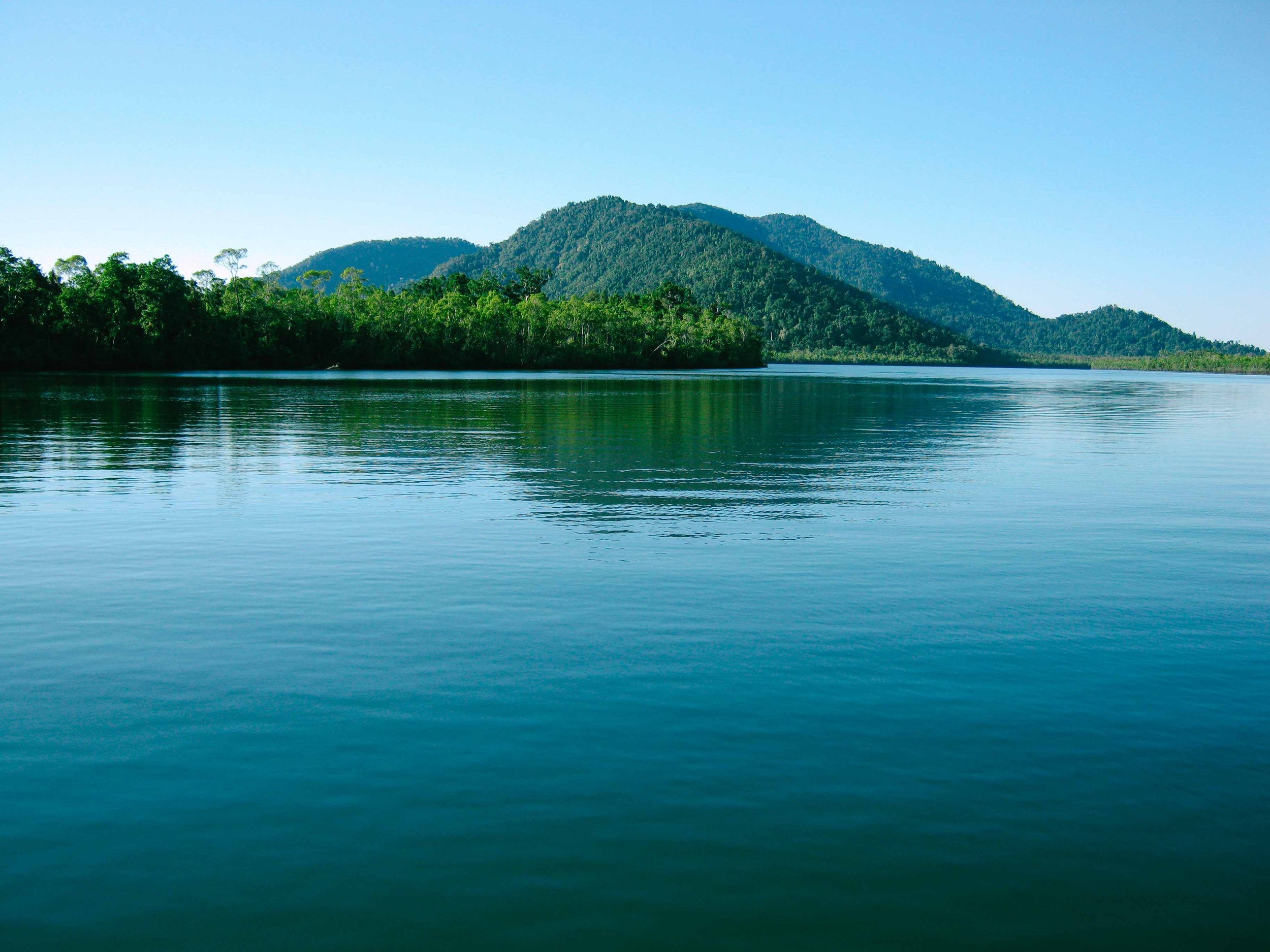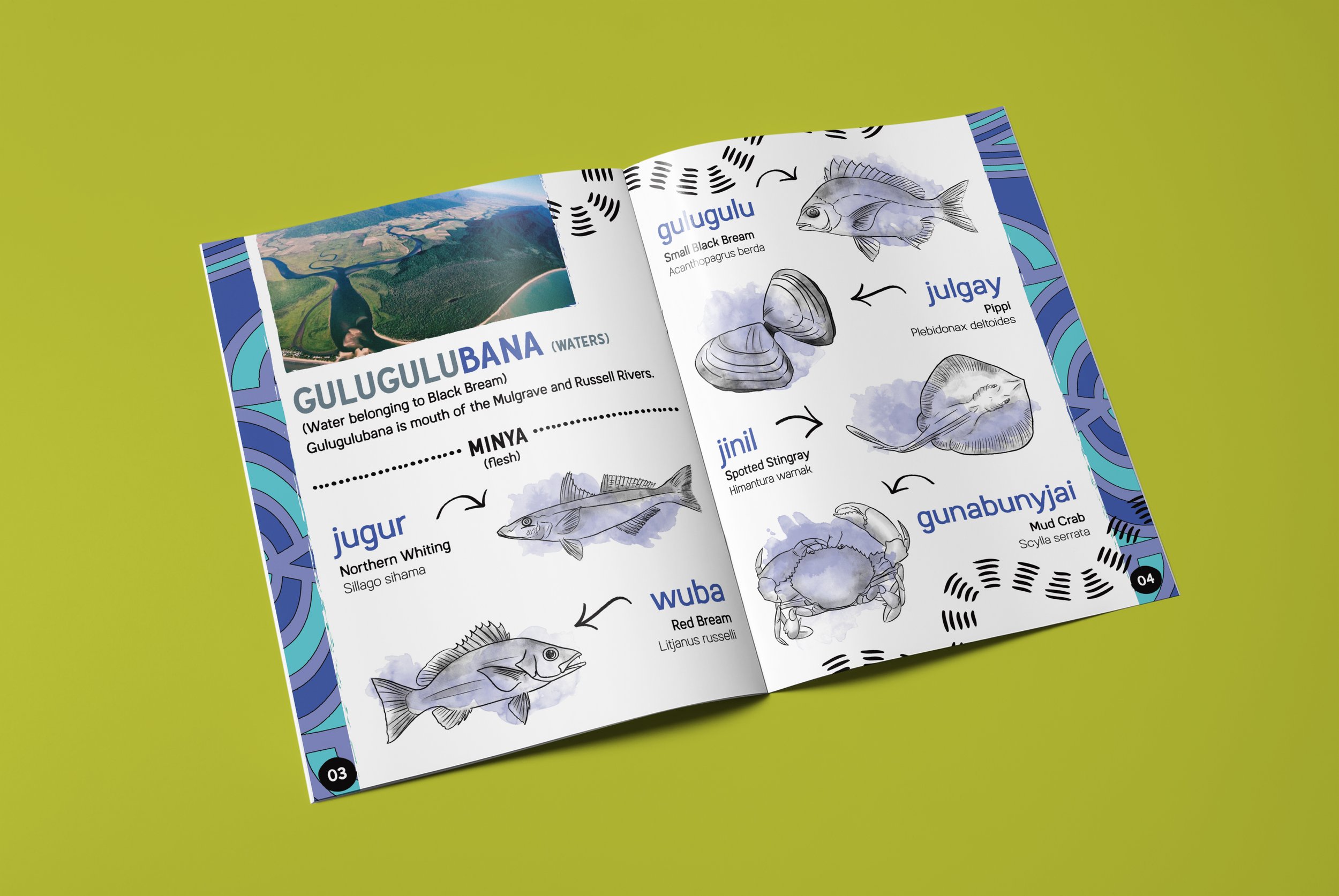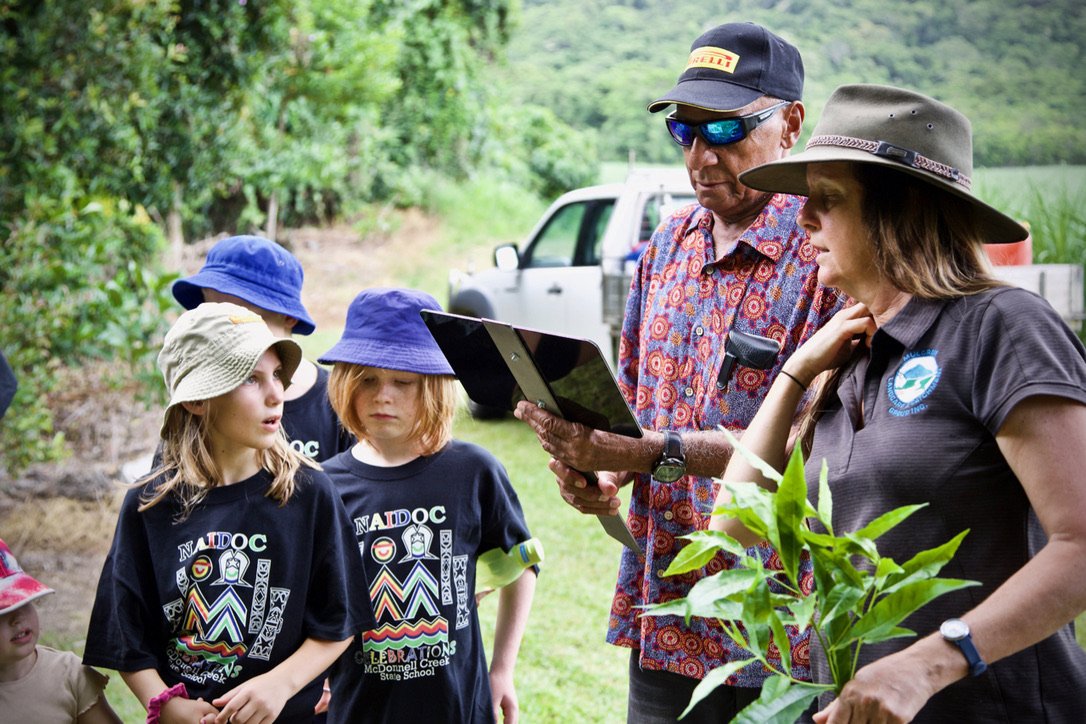Our Country
‘Country’ describes the complex layers of meaning associated with our place of origin and belonging, it’s our home, culture, language, identity, values, and knowledge. Country links the past and present, because of this richness and our deep connection with Country we feel and care for Country as we do for each other.
MadjayBana
The waters belogning to the Madjandji people.
Madjay - the Madjandji dialect
Bana - means water
Our People
Madjandji people were the earliest custodians of this area, the land and waters were our cultural and life supporting homeland that had always been part of our spiritual Dreamtime.
Madjandji People
Near Babinda 1893
Our Ancestral Estate
Madjandji Aboriginal Corporation hold a native title determination to parts of the Wooroonooran National Parks in Northeast Queensland, and are the Traditional Owners of the of the Country, including waters flowing from this native title determined land. A Madjandji Native Title application for these waters and country stretching into the lower Russell-Mulgrave Rivers, and into the Great Barrier Reef lagoon, with Palmer Point to the north, and Cooper Point along the southern coast is presently lodged and waiting on a decision from the Federal Court.
MadjayBana
The MadjayBana estate extends upstream until the saltwater becomes fresh water.
Maps of our traditional Madjandji Estate
Map of Wanyurr-Majay Native Title Determined area.
Aerial map of Wanyurr-Majay
land and waters.
Topographic map of Wanyurr Majay Regional Ecosystem.
Threats, actions, recommendations & monitoring to preserve & restore land.
Loss of natural environments
Urban development, clearing of land and the introduction of invasive flora and fauna all reduce the resilience of native habitats and its biodiversity.
Action
Expand on the Indigenous Ranger Program to implement our country based management plan to care for Traditional Gulgibarra land and waters. Rewilding degraded lands and waterways, re-establishing habitat connections to coastal lowland ecosystems through the removal of invasive weeds and pest species and re-introducing native vegetation that supports biodiversity and our culture.
Outcome
MAC has been working closely with landholders, NRM groups and Governmental organisations to work collaborative to restore degraded lands, improve biodiversity, promoting cultural well-being and connections to Country.
The re-vegetation of degraded farmland bordering Mulgrave River at Deeral is well underway with further projects commencing upstream to increase habitat connectivity. Our Madjaybana Rangers are working with the Department of Resources, Cairns Regional Council and Terrain NRM to re-establish the littoral rainforest along coastal Woolanmaroo. Madjandji Aboriginal Corporation assist landholders in the greater area of Babinda, supporting the restoration of riparian buffer zones to improve wildlife corridors and reduce stream bank erosion.
Our land restoration projects were funded by the Great Barrier Reef Foundation, the Department of Environment and Science, the Department of Resources, Terrain, Missionary Sisters of Service, and Greening Australia.
Habitat restoration
There is an urgent need to protect all our natural ecosystems.
The ecologist Peter Stanton highlighted the conservation significance and need for cultural fire regime to maintain important sclerophyll habitats of our coastal lowland Country, Woolanmaroo.
Woolanmaroo once supplied Traditional Owners with an abundance of Minya and Mayi. The endangered southern Cassowary and the Spectacled Flying Fox were once abundant here. Our Madjaybana Rangers are working closely with the Department of Resources, Cairns Regional Council and Terrain to repair the Woolanmaroo littoral rainforest, by removing invasive plant species, re-introducing native endemic plants and cultural burning. The rewilding by introducing native vegetation have resulted in that cassowary scats and footprints have been detected at our large revegetation site at Deeral. While Russell Heads residents have spotted cassowaries again swimming from the North Shore to the southern bank.
Madjaybana Rangers have received Cultural Burning training and qualifications with Fireground Leadership and Training to conduct Cultural burns and commenced CEM training with Jenegar.
See link to Management Plan – State Land and Council Reserve, Russell Heads, Woolanmaroo.
Future monitoring of habitats
Monitor and removal of introduced plants to aid natural habitat restoration, preventing further loss of important habitat and improving the visual amenity of target sites.
Assess soil and vegetation damages caused by severe weather events and tidal storm surges.
Monitor and record the extent of rubbish and marine debris in our natural habitats and share data with relevant authorities.
Monitor and record invasive species (e.g. Yellow Crazy Ants, Asian honeybee, feral pigs, etc) and reported to authorities.
Continue partnership with Birdlife Australia to identify and record the number of bird species attracted to re-vegetated sites with recommendations of plant species for inclusion in future re-vegetation projects.
Video of re-vegetation site, courtesy Franco Arri.
Our Waters
Waters from Wanyurr-Majay lands enter the Mulgrave-Russell River catchment flowing into the Great Barrier Reef Lagoon and Frankland Islands. Madjandji people wish to play a significant role in culturally informing, engaging, building partnerships, with inclusive participation addressing and improving the quality of waters on our lands.
These waters are of particular concern to our people, we have a spiritual connection to waters meandering through our lands.
Madjaybana is the traditional name for the saltwater reaches of the Mulgrave and Russell Rivers. (Majay is the Madjandji dialect and bana means water)
The traditional name for the lower reaches of the Mulgrave River is Gulugulubana meaning black bream waters
Gulugulubana
The Mulgrave and Russell Rivers Confluence. Photograph courtesy Terrain NRM
Threats, actions, recommendations & monitoring for all of Madjandji waters.
Loss of riparian vegetation including mangroves
Outcomes
Cairns and Far North Environment Centre (CAFNEC) are partnering with MAC to monitor the health of mangroves, riverbanks and the river conditions of the lower Mulgrave and Russell Rivers.
The data collected is used to prepare environmental baseline reports and to advise on a best practice Country Based management plan to restore resilience in these vital ecosystems.
MAC are in the progress of developing an education program to inform students about the significant value mangrove ecosystems. These ecosystems help reduce sediments entering the Great Barrier Reef lagoon, protect the coast against storm surges and are important as a nursery for young fish. The local area program (LAP) will be first launched at McDonnell State School and extended to other schools in the Mulgrave-Russell catchment in the near future.
Mangrove watch on the Russell River & local area planning.
Illegal dumping of rubbish and increased bank erosion
Investigation
The Great Barrier Reef Foundation has funded the Madjandji Healing Waters Project. Here we investigate illegal dumping of rubbish as well as bank erosion due to an increase in boat traffic on the river. We are also investigating how increased speed in marine traffic influence bank erosion. We will record this information to make recommendations from our Country Based Management Plan to improve the condition of our river.
Water Security Management Plan
Cairns Water Security Stage 1 Project with the Madjandji Aboriginal Corporation RNTBC is in the forming stages, developing the Cultural Heritage Management Plan (CHMP).
Culturally significant Gulugulubana
In accordance with the requirements of the Aboriginal Cultural Heritage Act 2003 (QLD), MAC has designed Informative and cautionary signage to be installed at the boat ramps on the Mulgrave and Russell Rivers. The signage, approved by Elders and endorsed by Cairns Regional Council promotes safety, conservation, and Cultural awareness.
Educational signage has been prepared for installation at the boat ramps to inform the public.
Monitoring water quality
Madjaybana Rangers have received training from the Department of Environment and Science, Mulgrave Landcare, and Farmacist, on how to collect, record and preserve water samples for scientific and eDNA analysis. Samples collected investigate the presence of endangered species and are tested for suspended solids; particle size, pH, electrical conductivity and turbidity, total nutrients: nitrogen, phosphorus, and organic carbon, and dissolved nutrients; phosphate, ammonium nitrogen, oxidised nitrogen, dissolved organic carbon and pesticides; (including ten photosystem II herbicides (e.g. diuron, atrazine), ten other herbicides (e.g. 2,4-Dichlorophenoxyacetic acid (2,4-D), metolachlor) and four insecticides (chlorpyrifos, fipronil, imidacloprid, diazinon). These pesticides are currently considered the greatest risk to coastal freshwater and marine aquatic ecosystems. Data collected will be shared with partners to develop a targeted Country Based Management Plans for individual creek.
Water sampling training with Dept. Environment & Science.
Madjaybana rangers water sampling.
Water quality monitoring and cultural values at Bana sites
The Madjaybana Rangers are working closely with the Mulgrave Russell Regional Water Quality Program (MRRWQP) and its delivery providers (Farmacist and JCU TropWater) in delivering the Madjandji Healing Waters Project. Our project will guide the MRRWQP on its cultural journey from our Country Based Management Plan to heal Country. Working with Farmacist, JCU TropWater and landholders to produce a targeted management plan for rehabilitation of significant Bana sites.
Madjandji people have lifetimes of practical traditional ecological knowledge of the water based minya (fauna) and mayi (flora) of Madjandji and Gulugulubana waters, seasonal/ ecological knowledge of local species will to be more systematically used in partnership with data co-produced with partners to supplement, enhance, and better monitor, measure, and manage the water quality and health of Madjaybana & Gulugulubana.
Our Culture
Our Cultural identity is linked to our ancestors, our language, knowledge, rituals, stories, and deep connection with Country.
Madjandji
Photograph taken by A.A White in 1904 from Mud Island, which once existed in Mutchero inlet.
Photograph courtesy John Oxley Library.
Threats, actions, recommendations & monitoring to preserve & revive Culture.
To rebuild, relearn, and revive our ancestral language
Outcomes
Language revival: Madjandji families continue to work with our Elders, Emerging Elders, digital designer, recording studio and our artists. Together we rebuild, relearn and revive our ancestral language, creating Madjandji learning resources. Funding for our language projects were received from the Department of Seniors, Disability Services and Aboriginal and Torres Strait Islanders Partnerships and the Department of Infrastructure, Transport, Regional Development and Communications.
Elders learn language.
Director and Emerging Elder Nathan Broom takes the lead at the language workshop.
Director Clive Murray teaches language to students.
Language booklets & posters were produced to introduce traditional language and serve as a teaching resource.
Rediscover, retrace and reconnect ancestral walking tracks
Outcomes
Madjaybana Rangers have started the journey to reconnect the ancestral walking track through the southern part of the Malbon-Thompson Forest Reserve, connecting Deeral with Aloomba and the coast with future aspirations to connect these ancestral walking tracks to Yarrabah. The tracks do not cross into any existing native title determination lands and this project is funded by the Department of Environment and Science.
Map of old logging trails which followed walking tracks in Woolanmaroo area.
Mapping of cultural sites
Action
MAC has appointed an Elders’ steering committee, a technical support team and established a ranger team to map and promote traditional knowledge, spiritual connection and cultural values of Country.
Cultural mapping of our culturally significant waters has commenced in partnership with Cairns Regional Council, Department of Resources, Queensland Parks & Wildlife Service and Farmacist.
Sites of cultural significance.
Gulugulubana
Members have fun Cultural Mapping Gulugulubana
Documenting stories
Outcomes
Ongoing workshops are giving Elders the opportunity to recall, write and record their stories.
Cecilia shares her story
Truth telling
Action
A lack of a shared understanding of our history both within the indigenous and broadercommunity is of concern and a roadblock to healing and reconciliation. Madjandji Elders and corporation members share a mission to progress truth-telling and share the Madjandji story to promote acceptance and empathy.
Funding has been received under the Celebrating Reconciliation Grant for the delivery of Madjandji Truth Telling.
Promote Cultural Awareness
Action
NAIDOC has always provided a platform to share our Culture with the broader community. Past activities have included the establishment of a bush tucker plot at the local school, Cultural art activities and language learning for students, and Elders storytelling.
NAIDOC
Preparing for the bush tucker plot with Landcare Lisa & Clive Murray.






























